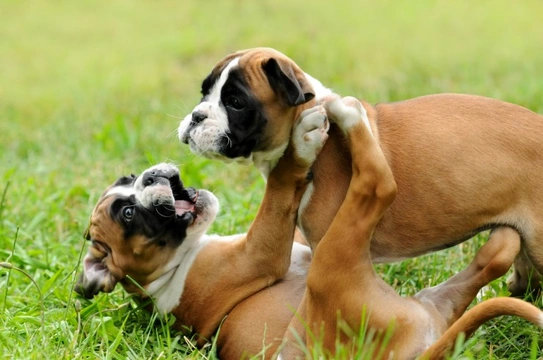
Dog interaction - How to tell enthusiastic play from a fight in the making
Socialisation is vitally important for all dogs, and from puppyhood onwards all dogs should be given plenty of opportunities to play with other dogs on a regular basis, such as in the dog park or with other dogs that you meet when out walking.
Dogs learn all of the various social niceties that come with interacting with others from a young age-while a pup is still with their dam and the rest of their litter, they will already be picking up the basics of bite inhibition, cues to calm down, and all of the other skills that will be important when they get older.
This learning process continues when the pup starts to go out and meet strange dogs and play with them-older dogs will usually give younger dogs some leeway in terms of their behaviour, correcting them when necessary, but generally being a lot more tolerant than they would be with another adult dog.
Even when playing and having a great time, you may well see dogs growling, wrestling, throwing each other about and generally getting very excitable and enthusiastic to the point of roughness-and intervening in what is simply normal, if slightly rough play is a major mistake. Dogs need to be able to play and interact with each other freely, without their human handlers stepping in every time things get a little lively-but do you know how to tell the difference between enthusiastic or even rough play, and a potential fight in the making?
In this article, we will teach you how to identify simple play that may be rather vigorous from a potential fight in the making, by reading the dogs’ body language and other cues. Read on to learn more.
Mock-fighting and fun cues
Dogs use play and socialisation to explore their relationships with each other, and in some cases, to explore new things, such as being the boss dog for a few minutes or wrestling and pretending to fight. The key to being able to tell a fight in the making from normal, lively play comes from learning to interpret body language, and to know the type of cues to look out for that indicate that both dogs are happy and having fun, and that things are not getting out of hand.
Play between dogs can get pretty rough, and it is important to understand this and not intervene if this is all that is going on. Dogs that are well socialised and like to play with others will have clear cues and signals that they pass between themselves when at play to let each other know that things are ok, or if they are going a little too far.
If the dogs are bounding around and appear jaunty and bouncy, perhaps bounding at each other and trying to incite each other to play, this is normal and likely very enjoyable for both dogs. Dogs at play will have a relaxed jaw (often with an open mouth) and mobile ears that are not held erect nor flattened back. They may also deliberately expose their throat and belly to each other, which is a sign of trust and an understanding that they are just playing, and not having a fight.
Bowing to each other is a solid invite to play or to take things up a notch, and perhaps the main cue that indicates that both dogs are having a good time and are happy with things is if both dogs remain engaged and active in the game, winding each other up as they go!
If one dog has had enough, they will retreat-the other dog may attempt to involve them in the game again, but after being snubbed a couple of times, the chances are that they will back off.
Potential indicators of a problem
There can be a fine line between play and overstimulation, and if the game reaches the point of overstimulation, one dog will back off. If the other dog permits this then the situation will diffuse itself immediately, but if the more dominant dog continues to pursue the other party when they are taking a time out, this can lead to a flashpoint that can turn to snarling or the opening of a potential fight.
A dog that has had enough or that is finding things are going a little too far will get progressively stiffer in the body, and this will manifest along their spine, in the posture of the tail, and in the position of the ears. That open mouth may take on a fixed expression too, which are all warnings to the other dog to calm things down.
If the other dog listens and respects this, there is no need to intervene-but the point at which you should recall the dogs is if the main culprit will not leave the other dog alone when they are trying to retreat.
Other flashpoints in otherwise friendly dog play can occur in competition over toys-for instance, if one dog is trying to take a toy from another who is not keen to share. For this reason, it is a good idea to leave favourite toys at home when going out to play with other dogs, or to keep a certain ball or toy for interactive play only, so that your dog does not begin to see it as something that they need to protect!



